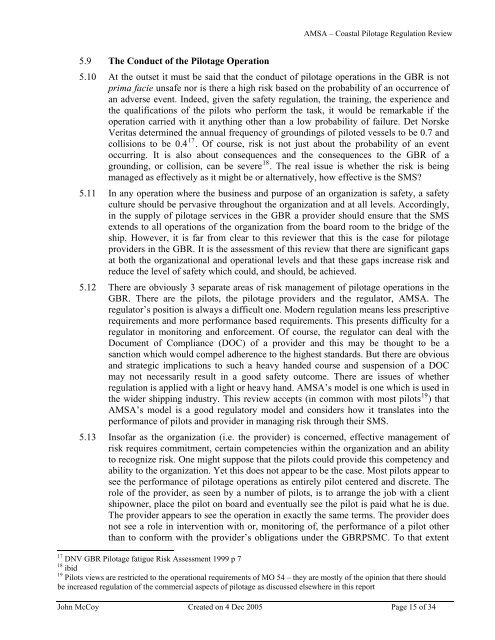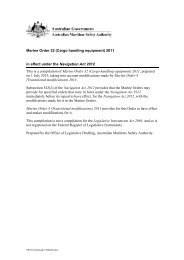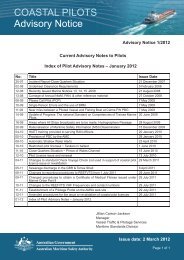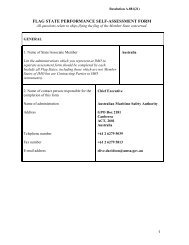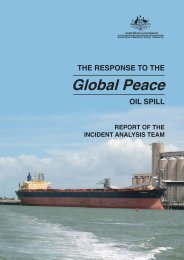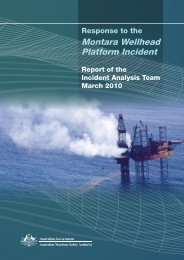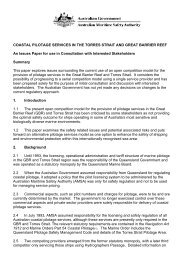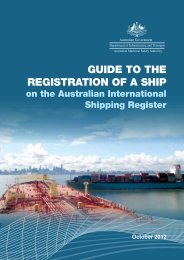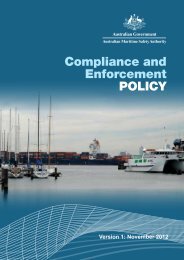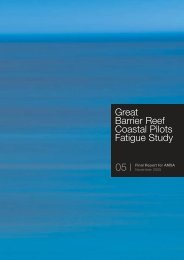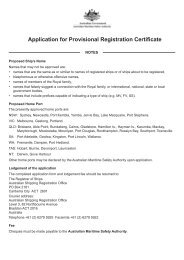Coastal pilotage regulation review - Australian Maritime Safety ...
Coastal pilotage regulation review - Australian Maritime Safety ...
Coastal pilotage regulation review - Australian Maritime Safety ...
Create successful ePaper yourself
Turn your PDF publications into a flip-book with our unique Google optimized e-Paper software.
AMSA – <strong>Coastal</strong> Pilotage Regulation Review5.9 The Conduct of the Pilotage Operation5.10 At the outset it must be said that the conduct of <strong>pilotage</strong> operations in the GBR is notprima facie unsafe nor is there a high risk based on the probability of an occurrence ofan adverse event. Indeed, given the safety <strong>regulation</strong>, the training, the experience andthe qualifications of the pilots who perform the task, it would be remarkable if theoperation carried with it anything other than a low probability of failure. Det NorskeVeritas determined the annual frequency of groundings of piloted vessels to be 0.7 andcollisions to be 0.4 17 . Of course, risk is not just about the probability of an eventoccurring. It is also about consequences and the consequences to the GBR of agrounding, or collision, can be severe 18 . The real issue is whether the risk is beingmanaged as effectively as it might be or alternatively, how effective is the SMS?5.11 In any operation where the business and purpose of an organization is safety, a safetyculture should be pervasive throughout the organization and at all levels. Accordingly,in the supply of <strong>pilotage</strong> services in the GBR a provider should ensure that the SMSextends to all operations of the organization from the board room to the bridge of theship. However, it is far from clear to this <strong>review</strong>er that this is the case for <strong>pilotage</strong>providers in the GBR. It is the assessment of this <strong>review</strong> that there are significant gapsat both the organizational and operational levels and that these gaps increase risk andreduce the level of safety which could, and should, be achieved.5.12 There are obviously 3 separate areas of risk management of <strong>pilotage</strong> operations in theGBR. There are the pilots, the <strong>pilotage</strong> providers and the regulator, AMSA. Theregulator’s position is always a difficult one. Modern <strong>regulation</strong> means less prescriptiverequirements and more performance based requirements. This presents difficulty for aregulator in monitoring and enforcement. Of course, the regulator can deal with theDocument of Compliance (DOC) of a provider and this may be thought to be asanction which would compel adherence to the highest standards. But there are obviousand strategic implications to such a heavy handed course and suspension of a DOCmay not necessarily result in a good safety outcome. There are issues of whether<strong>regulation</strong> is applied with a light or heavy hand. AMSA’s model is one which is used inthe wider shipping industry. This <strong>review</strong> accepts (in common with most pilots 19 ) thatAMSA’s model is a good regulatory model and considers how it translates into theperformance of pilots and provider in managing risk through their SMS.5.13 Insofar as the organization (i.e. the provider) is concerned, effective management ofrisk requires commitment, certain competencies within the organization and an abilityto recognize risk. One might suppose that the pilots could provide this competency andability to the organization. Yet this does not appear to be the case. Most pilots appear tosee the performance of <strong>pilotage</strong> operations as entirely pilot centered and discrete. Therole of the provider, as seen by a number of pilots, is to arrange the job with a clientshipowner, place the pilot on board and eventually see the pilot is paid what he is due.The provider appears to see the operation in exactly the same terms. The provider doesnot see a role in intervention with or, monitoring of, the performance of a pilot otherthan to conform with the provider’s obligations under the GBRPSMC. To that extent17 DNV GBR Pilotage fatigue Risk Assessment 1999 p 718 ibid19 Pilots views are restricted to the operational requirements of MO 54 – they are mostly of the opinion that there shouldbe increased <strong>regulation</strong> of the commercial aspects of <strong>pilotage</strong> as discussed elsewhere in this reportJohn McCoy Created on 4 Dec 2005 Page 15 of 34


